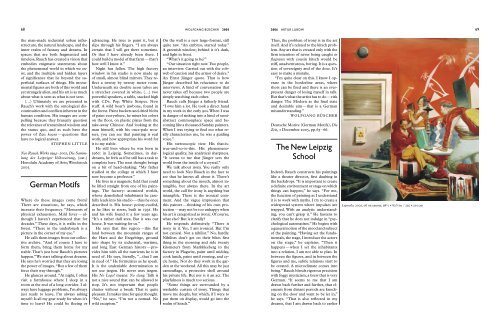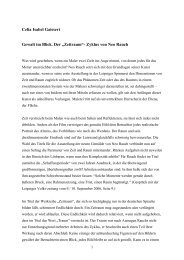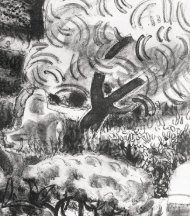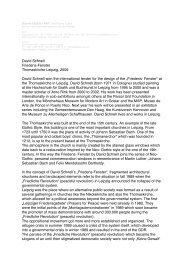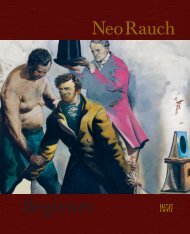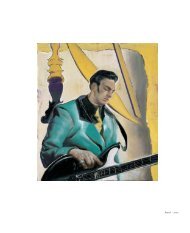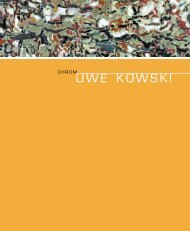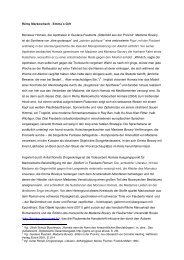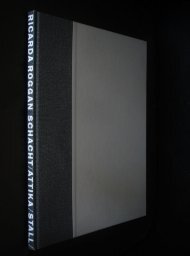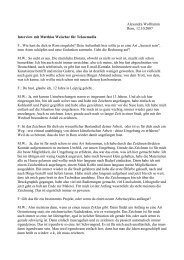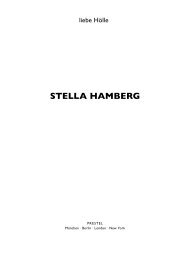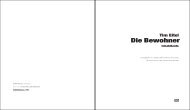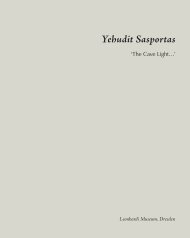Durch Rauch gesehen - Galerie EIGEN+ART
Durch Rauch gesehen - Galerie EIGEN+ART
Durch Rauch gesehen - Galerie EIGEN+ART
Erfolgreiche ePaper selbst erstellen
Machen Sie aus Ihren PDF Publikationen ein blätterbares Flipbook mit unserer einzigartigen Google optimierten e-Paper Software.
68 WOLFGANG BÜSCHER 2005 2006 ARTUR LUBOW<br />
69<br />
the man-made industrial urban infrastructure,<br />
the natural landscape, and the<br />
inner realm of fantasy and dreams. In<br />
spaces that are both fragmented and<br />
timeless, <strong>Rauch</strong> has created a vision that<br />
embodies enigmatic statements about<br />
the phenomenal world in which we exist,<br />
and the multiple and hidden layers<br />
of significance that lie beyond the superficial<br />
surfaces of things. His monumental<br />
figures are both of this world and<br />
yet strangely alien, and his art is as much<br />
about what is seen as what is not seen.<br />
(…) Ultimately we are presented in<br />
<strong>Rauch</strong>’s work with the ontological discontinuities<br />
and conflicts inherent in the<br />
human condition. His images are compelling<br />
because they brazenly question<br />
the relevance of transmitted wisdom and<br />
the status quo, and as such have the<br />
power of Zen koans — questions that<br />
have no logical answer.<br />
STEPHEN LITTLE<br />
Neo <strong>Rauch</strong>. Works 1994–2002, Die Sammlung<br />
der Leipziger Volkszeitung, (cat.)<br />
Honolulu Academy of Arts; Woodstock<br />
2005.<br />
German Motifs<br />
Where do these images come from?<br />
There are situations, he says, which<br />
increase their frequency. “Moments of<br />
physical exhaustion. Mild fever — although<br />
I haven’t experienced that for<br />
decades.” These days, it is walks in the<br />
forest. “There in the underbrush is a<br />
picture in the corner of my eye.”<br />
He calls them images from our collective<br />
archive. “And of course I have to<br />
form them, bring them home for my<br />
stable. That’s just how <strong>Rauch</strong>’s pictures<br />
happen.” We start talking about dreams.<br />
He says he’s worried that they are losing<br />
the power of images. “But a few of them<br />
force their way through.”<br />
He glances around. “At night, I often<br />
visit a farmhouse where I sleep in a<br />
room at the end of a long corridor. I always<br />
have luggage problems, I’m always<br />
just ready to leave, I’m always asking<br />
myself: Is all my gear ready for when it’s<br />
time to leave? He could be fleeing or<br />
advancing. He tries to paint it, but it<br />
slips through his fingers. “I am always<br />
certain that I will get there sometime.<br />
Or that I have already been there. I<br />
could build a model of that farm — that’s<br />
how well I know it.”<br />
Night has fallen. The high factory<br />
window in his studio is now made up<br />
of small, almost blind mirrors. They reflect<br />
a twenty by twenty meter room.<br />
Underneath six double neon tubes are<br />
a stretcher covered in white, (…) two<br />
powerful speakers, a table, stacked high<br />
with CDs. Pop. White Stripes. New<br />
stuff. A wild boar’s jawbone, found in<br />
the forest. Paint buckets and dried blobs<br />
of paint everywhere, he mixes his colors<br />
on the floor, on plastic plates from the<br />
take-away Chinese. And looking at the<br />
man himself, with his once-pale trousers,<br />
you can see that painting is real<br />
work, and how appropriate his word for<br />
it is: my stable.<br />
He still lives where he was born in<br />
1960: in Leipzig. Sometimes, in daydreams,<br />
he feels as if he still has a task to<br />
complete here. The next thought brings<br />
on a bit of head-shaking: “My father<br />
studied at the college at which I have<br />
now become a professor.”<br />
He lives in a magnetic field that could<br />
be lifted straight from one of his paintings.<br />
The factory: atomized worlds,<br />
whose demolished inhabitants he carefully<br />
leads into his studio — thus he once<br />
described it. His house: pointy-roofed,<br />
as he likes to stress, built in 1931. He<br />
and his wife found it a few years ago.<br />
“It’s a rather dull area. But it was our<br />
house. It was waiting for us.”<br />
He says that this region — this flat<br />
land between the mountain ranges of<br />
the Harz and the Erzgebirge, ground<br />
into shape by its industrial, wartime,<br />
and long East German history — provides<br />
him with all the nutrients he is in<br />
need of. He says, literally, “...that I am<br />
in need of.” He formulates as he speak.<br />
It is the undeniable determination to<br />
not use jargon. He never uses jargon.<br />
His No Logo! means: No slang. Talk is<br />
not a nice sound that can be allowed to<br />
stop. It’s not important that people<br />
chatter without a break. That is quite<br />
pleasant. It makes time for quiet thought.<br />
“No,” he says. “I’m not a nomad. No<br />
wild escapism.”<br />
On the wall is a new large-format, still<br />
quite raw. “An embryo, started today.”<br />
A greenish window; behind it it’s dark,<br />
and light in front.<br />
“What’s it going to be?”<br />
“Our situation right now. Two people,<br />
an interview. Carried out with the cobweb<br />
of caution and the armor of desire.”<br />
An Ernst Jünger quote. That is how<br />
Jünger described his reluctance to do<br />
interviews. A kind of conversation that<br />
never takes off because two people are<br />
simply watching each other.<br />
<strong>Rauch</strong> calls Jünger a fatherly friend.<br />
“I owe him a lot. He took a direct hand<br />
in my work in the early 90s. When I was<br />
in danger of sinking into a kind of semiabstract<br />
commonplace space and becoming<br />
like a thousand Sunday painters.<br />
When I was trying to find out what really<br />
characterizes me, he was a guiding<br />
voice.”<br />
His stereoscopic view. His that-istrue-and-so-is-this.<br />
His phenomenological<br />
quality, his analytical sharpness.<br />
“It seems to me that Jünger sees the<br />
world from the inside of a crystal.”<br />
We talk about irony. You really only<br />
need to look Neo <strong>Rauch</strong> in the face to<br />
see that he knows all about it. There’s<br />
something about the mouth, almost intangible,<br />
but always there. In the art<br />
world, the call for irony is anything but<br />
intangible. There is the ironical comment.<br />
And the vague impression that<br />
this painter — thinking of his own protection<br />
— may not be too unhappy when<br />
his art is categorized as ironic. Of course,<br />
what else? But is it really?<br />
He responds defensively. “There is<br />
irony in it. Yes, I am ironical. But I’m<br />
not cynical. Not a nihilist.” No, hardly.<br />
Nihilists don’t get on their bikes first<br />
thing in the morning and ride twenty<br />
kilometers from Markkleeberg to the<br />
factory in Plagwitz, paint until midday,<br />
cook lunch, paint until evening, and cycle<br />
home. Nor do they work in the garden<br />
at the weekend. All this may be just<br />
camouflage, a protective shell around<br />
his private life. But nor is it an act. The<br />
playfulness is much too serious.<br />
“Some things are surrounded by a<br />
washable curtain of irony. Things that<br />
move me deeply, but which, if I were to<br />
put them on display, would go into the<br />
realm of kitsch.”<br />
Thus, the problem of irony is in the art<br />
itself. And it’s related to the kitsch problem.<br />
Any art that is created only with the<br />
firm intention of never being caught in<br />
flagrante with cousin kitsch would be<br />
stiff, unadventurous, boring. It is a question<br />
of sovereignty and of the dose. It’s<br />
easy to make a mistake.<br />
“I’m quite clear on this. I know I operate<br />
in the borderline areas, where<br />
shots can be fired and there is an everpresent<br />
danger of losing myself in talk.<br />
But that’s what the artist has to do — risk<br />
danger. The Modern as the final state<br />
and desirable aim — that is a German<br />
misunderstanding.”<br />
WOLFGANG BÜSCHER<br />
Deutsche Motive (German Motifs), Die<br />
Zeit, 1 December 2005, pp. 65– 66.<br />
The New Leipzig<br />
School<br />
Indeed, <strong>Rauch</strong> constructs his paintings<br />
like a theater director, first daubing in<br />
the backdrops. “It is important to create<br />
a definite environment or stage on which<br />
things can happen,” he says. “For me,<br />
the function of painting as I understand<br />
it is to work with myths. I try to create a<br />
widespread system where impulses are<br />
trapped. With an analytic understanding,<br />
you can’t grasp it.” He hastens to<br />
clarify that he does not indulge in “psychological<br />
automatism.” He begins with<br />
a general notion of the mood and subject<br />
of the painting. “Having set the fundamentals,<br />
the stage, I introduce the actors<br />
on the stage,” he explains. “Then it<br />
happens — when I set the inhabitants<br />
into a relation, I am not able to plan. In<br />
between the figures, and in between the<br />
figures and me, subtle relations start to<br />
be created. A microclimate comes into<br />
being.” <strong>Rauch</strong> blends rigorous precision<br />
with foggy mysticism, a brew that is very<br />
German. “It seems to me that I am<br />
drawn back further and further, that elements<br />
from distant periods are knocking<br />
on the door and want to be let in,”<br />
he says. “That is also reflected in my<br />
dreams, that I am drawn back to earlier<br />
Leporello, 2005, oil on canvas, 98½ × 82⅝ in ⁄ 250 × 210 cm


